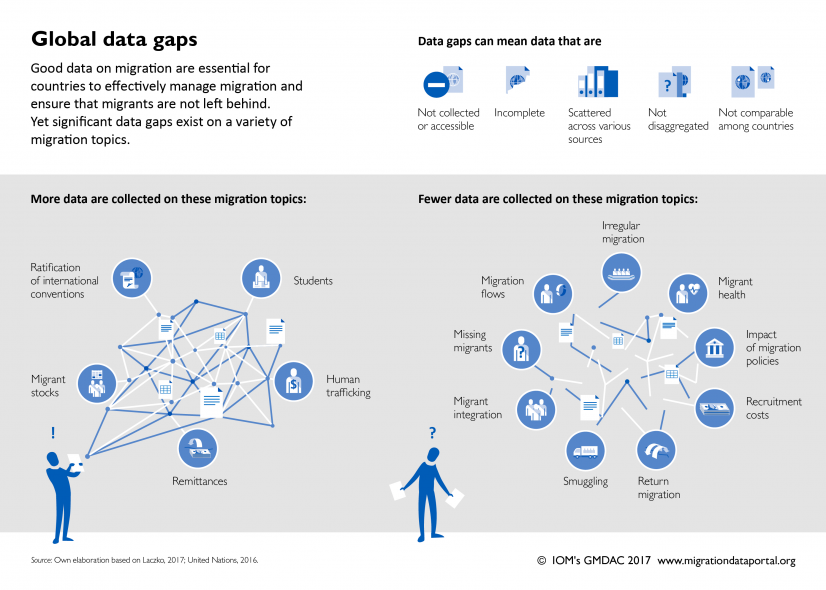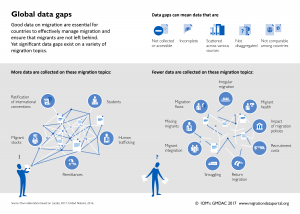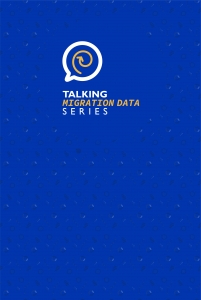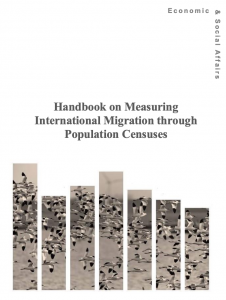Migration data sources
The demands for migration data arising from the 2030 Agenda for Sustainable Development have prompted the international statistical community to review the use of traditional sources for migration data, such as population and housing censuses, household surveys and administrative records. There is also increased interest in looking for alternative sources to enhance the collection and analysis of migration data.
The better use and understanding of existing data sources are essential to improve migration management and policy. Information about migration comes from a variety of data sources that have strengths and limitations and can be used to produce different migration statistics.
Click on the below infographic to make it interactive.
Back to topDefinition
Sources of migration data can be broadly grouped into three categories:
Statistical data sources: These sources include national population and housing surveys. Data from these sources are collated, cleaned, edited, imputed, aggregated and used to produce official statistics.
Administrative data sources: Most countries have administrative procedures to register foreigners or to grant permits to stay in the country. Examples include tourist visas, work visas and study permits. Although still not fully recognized as a source of migration statistics in many countries, these administrative records can, to some extent, identify and analyze migrant stocks and flows.
Innovative data sources: Fueled by rapid technological advancement, an increasing amount of migration-related information is now available from the private sector. An unprecedented amount of data, commonly known as “big data”, have been generated through the use of digital devices such as mobile phones, internet-based platforms such as social media, and online payment services. A growing body of research attempts to present the various ways in which the use and analysis of big data can help elucidate forced displacement, transnational networks, human trafficking or estimate remittance flows.
Recent trends
In September 2015, the United Nations (UN) General Assembly adopted the 2030 Agenda for Sustainable Development. The Agenda recognizes international migration as an integral part of sustainable development. Furthermore, the New York Declaration for Refugees and Migrants includes several references to the importance of collecting better data.
The inclusion of migration in the new global development framework poses several new challenges for national-level statistical systems. Better use of existing data sources, as well as developing new methods to collect data on migration will be required, in particular:
- Censuses will need to provide more disaggregated data by migratory status in order to ensure “no migrant is left behind”—the 2030 Agenda’s guiding principle. Given that national preparations for the 2020 round of censuses are currently underway in many countries, countries are encouraged to continue including questions to identify migrants (country of birth, country of citizenship and year/period of arrival), as recommended by the UN Principles and Recommendations for Population and Housing Censuses.
- The compilation and analysis of administrative data from national sources will need to better indicate global migration flows and policy responses.
- The addition of migration questions to surveys will be required in order to collect more comprehensive national and international migration data.
- Innovative data sources, such as big data sources, will have to be better monitored and implemented in order to track migration flows and ensure all migrants are recorded.
Data sources
Census and surveys collect migration-related data which can be used to produce official statistics. For example:
- Censuses produce statistics on migrant stocks, socio-economic characteristics, migrant flows (limited) and some emigration figures. The UN Statistics Division recommends including three core variables in population censuses to identify international migrants. They are: (1) country of birth, (2) country of citizenship, and (3) year or period of arrival in the country for foreign-born persons.
- Household surveys produce statistics on different aspects, such as the drivers and the impact of migration, internal migration, socio-economic characteristics, emigration, migrant stocks and flows of immigrants and emigrants.
- Labour Force Surveys produce statistics on migrant stocks in the labour market.
Administrative sources collect data for purposes other than gathering information on migration, but may be useful in the collection of specific indicators. Statistics derived from data in these sources usually refer to administrative records rather than people. Some examples of sources include:
- Administrative registers that can potentially produce information on certain groups of persons who change their country of usual residence and thus qualify as international migrants.
- Border data collection systems which produce statistics on flows of nationals and non-nationals entering and leaving through official border posts.
- Visas, residence permits, and/or work permits that produce statistics on migrant flows and stocks, drivers and impact of migration, and socio-economic characteristics
Innovative data sources—Although the availability of migration statistics from traditional sources is useful to some extent, significant gaps remain, as outlined above. Mobile phones, online tools and platforms, such as social media or online payment services, have become a potentially useful source for migration data. For example:
- Big data sources, such as social media and call detail records can produce statistics on migrant flows, drivers and impact of migration, and internal migration.
Information produced by innovative sources includes: migrant flows, drivers and impact of migration, internal migration, public opinion on migration, among others.
Back to topData strengths & limitations
Depending on the source, various strengths and limitations can present when analyzing available data sources for migration.
Statistical sources: These sources, such as censuses, household surveys and labour force surveys, are universal, and allow cross-country comparability; they can also offer detailed data on small population groups. However, depending on the country, surveys might be infrequent and/or costly. Surveys can also present issues with sample size and coverage, and migration questions tend to be left out.
Administrative sources: Administrative sources can provide detailed and continuous data on small groups. However, visas, residence permits and work permits, while continuous and comprehensive, lack comparable definitions, coverage and availability between countries or ministries within the same country. Furthermore, they often do not cover naturalized citizens or undocumented residents who overstay their visas. It is also important to note that, for example, if a person receives more than one residence permit in a year, or if the permit granted to the head of the family covers his or her dependents, data may not reflect the total number of migrants in the country of residence.
Innovative sources: Big data sources are timely and provide real-time data; they also have broad coverage and are automatically collected. Some limitations to these sources are that they can be biased and there are privacy and ethical issues with the collection and use of these data.










